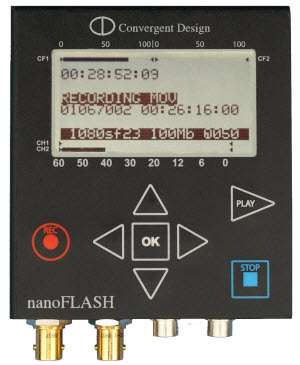Nanoflash from convergent Design – HDMI capture example

Some of you may be aware that for over a couple of years now I been on the forefront of HDMI capture and attempting to make it easier to do in the field. Well I held off for a few months but last month I eventually succumbed and bought the Nanoflash from convergent design. Capable of recording to compact flash cards the Nanoflash is a dream for anybody wanting to enter the realm of high quality HDMI capture. Of course the product can also capture to HD-SDI. I have made myself a DIY battery that can last a whole day if need be.
The output file is either i-frame or longop – ( long group of pictures ) and I will be recording to 180 mbps longop which surpasses anything the DIY project I did can achieve. The data rate at 8 bit technically has more information than the film scan rate of cineform at 10 bit. This makes it perfect for consumer camcorders like the HFS10.
Have a look at what it looks like in action. Go to Vimeo, login and download the original to get a feel for the detail captured.I was blown away.
HDMI capture,HFS10, SGBlade, Nanoflash, Nikkor 85 mm AI from Henry Olonga on Vimeo.

Henry,
Are you saying that the nanoFlash records a higher quality image from 8-bit cameras than does Cineform at the highest quality?
Thanks much.
Hi Peter,
The data rate at 160 mbps longop is about 20 MB/s 8 bit 4.2.2.
At 280 mbps i-frame the nanoflash data rate is 35 MB/s
The highest setting for Cineform is about 24 MB/s but that is 10 bit.
The intensity is an 8 bit card so capturing to Cineform just pads the last 2 bits so it is an artificially inflated file size.
If the source is 8 bit then nanoflash maximises it, recording at a similliar data rate.
If I change a Nanoflash file to Cineform the file size is smaller. Therefore by my reasoning the Nanoflash is higher quality recorder and much more convenient. I am not a scientist however. I have compared both and the Nanoflash looks slightly better to my eyes. This wasn’t a scientific test mind you.
They however are both excellent ways of procuring high quality footage. They are both visually lossless.
Thanks Henry,
You’re one of the few people who’ve used both, so thanks for your perspective :).
Peter